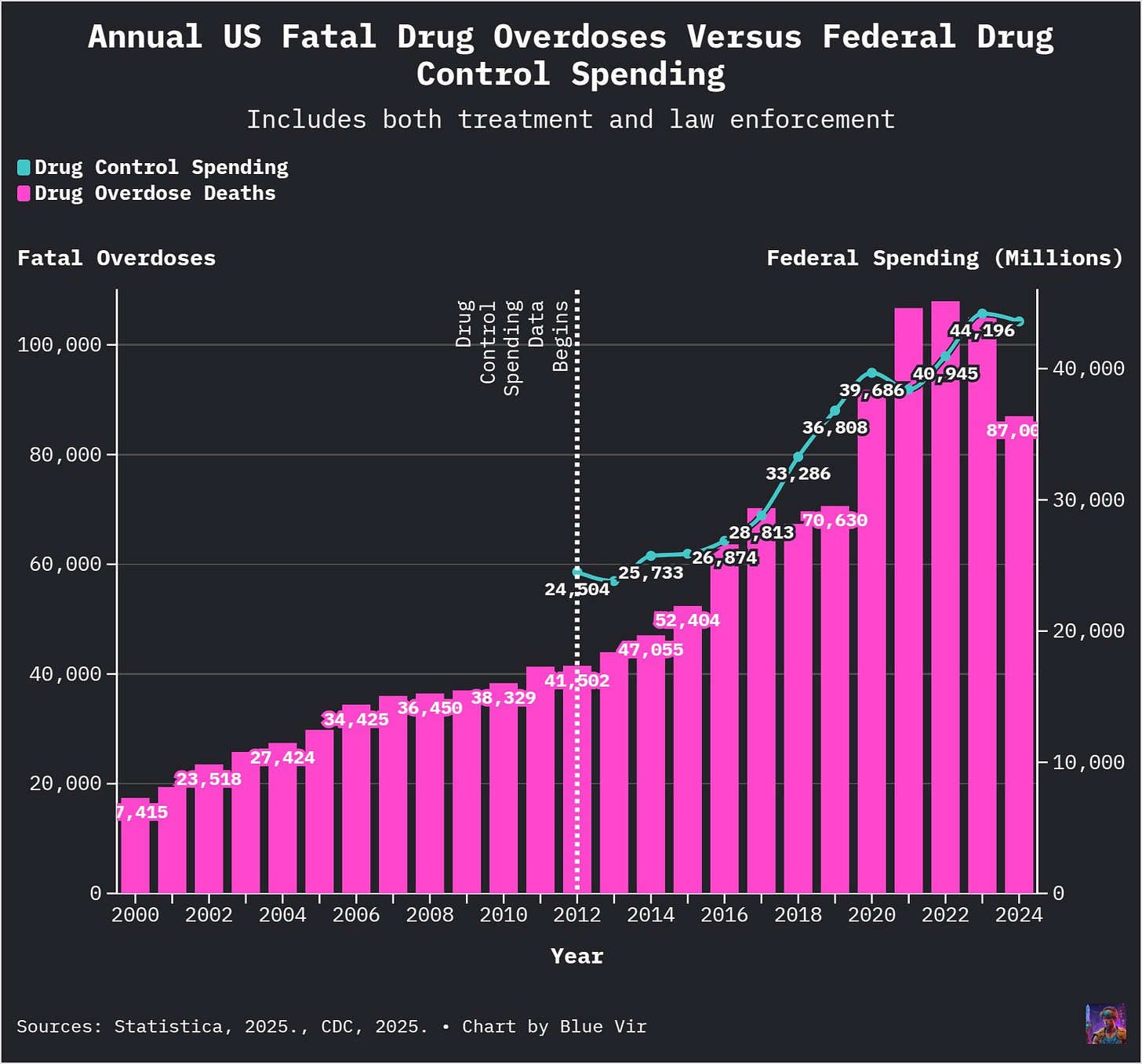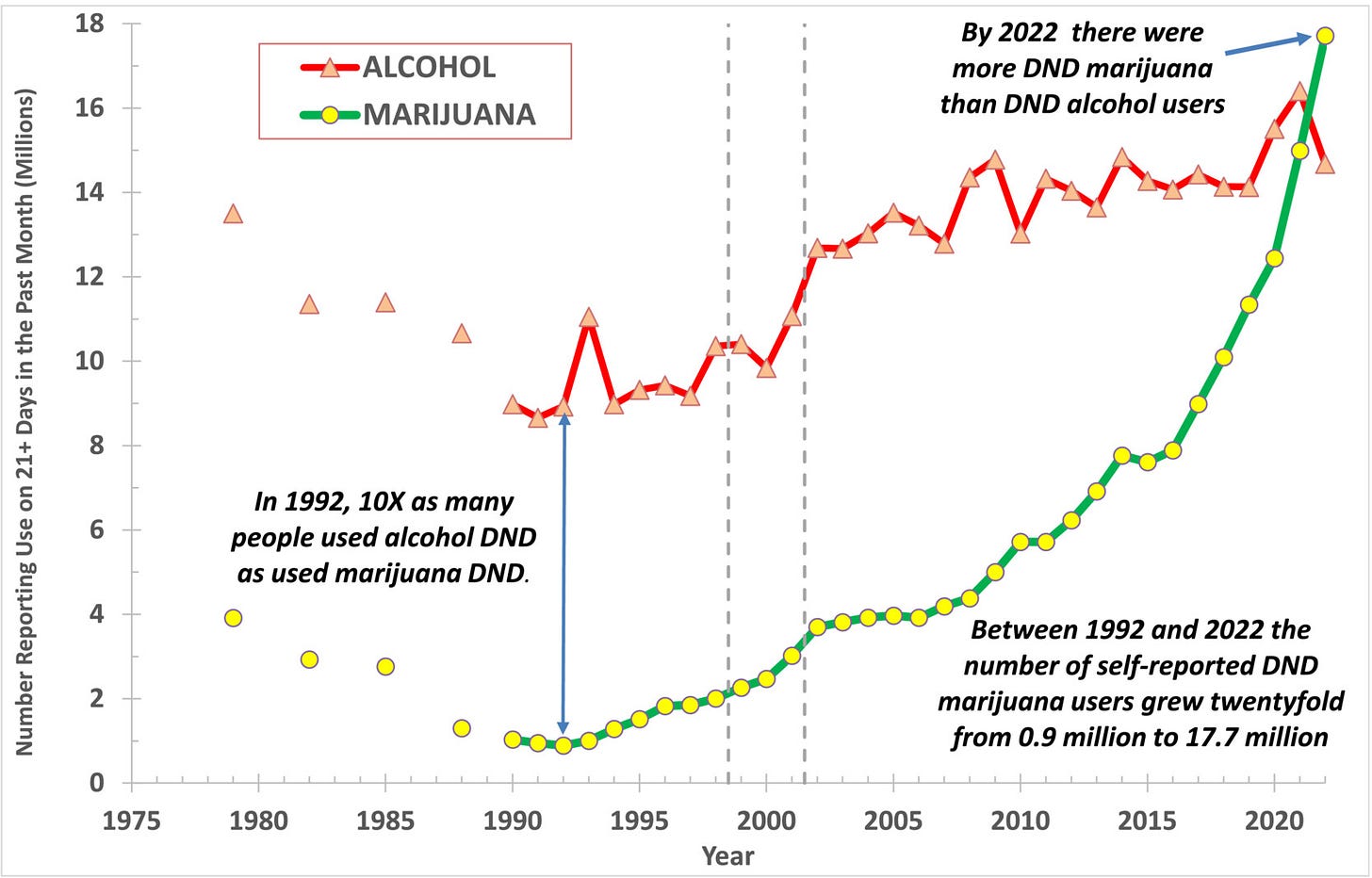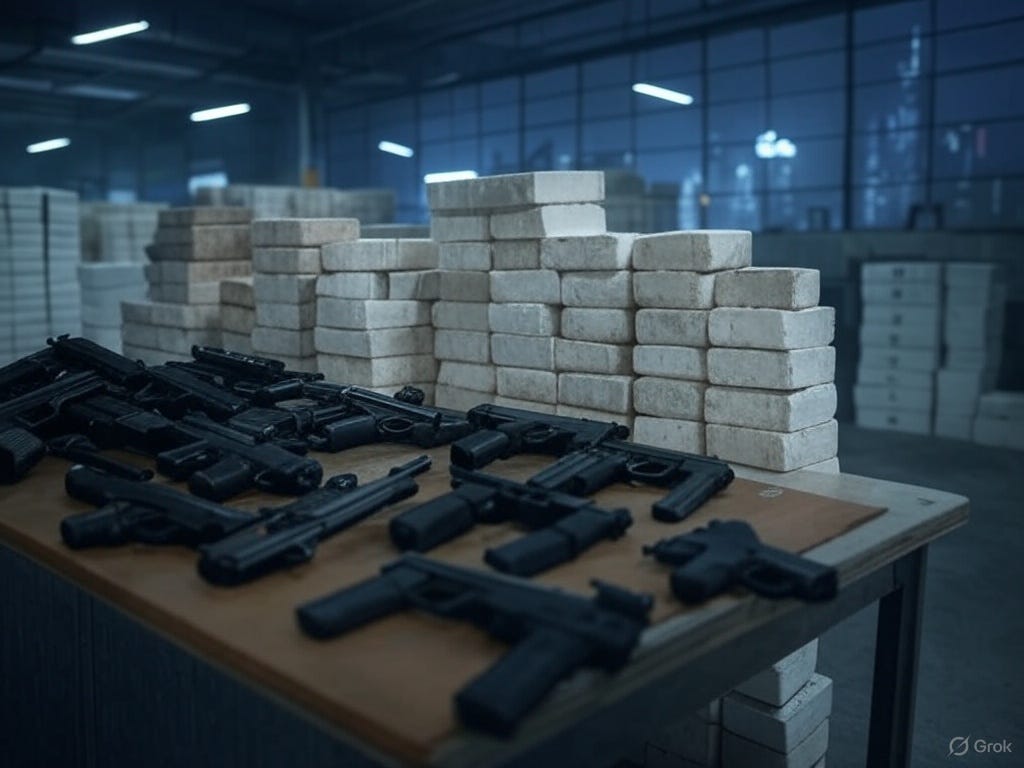Drug Flood: The State's Failure to Contain Drugs and Our Future Elites
More Cyberpunk, less 1984
Introduction
The drug legalisation versus criminalisation debate is often framed as a choice that society can make. I believe that the spread of drugs through North America is an involuntary process. The criminalisers think that they can stop or at least severely limit the flow of drugs over a large area, while the legalisers believe that they can most minimise harm within their society and beyond by legalising drugs. Both are wrong. The last 60 years of the drug issue has severely eroded the drug criminalisation side.
I do not make moral arguments with this. It is fact that drug laws and enforcement have loosened and at the same time drug players have gained immense wealth and power in the main ‘home base’ of Latin America. This goes against the legalisers’ idea that loosening drug laws will make the cartels disappear and obviously also means that drug criminalisers are losing. “Oh, but see we were right, you don’t get rid of cartels by loosening drug enforcement” you may hear the criminaliser snicker. But this is a common conservicuck habit. He lost in real life as drugs and the cartels’ power is flourishing, yet he still thinks he won because his theory was proven correct.
In this article I speculate on the future of drug enforcement, the effects of increasing drug use, a rising narco-social-elite and the decline of state capacity, with a focus on North America.
Expense of Drug Enforcement and Failures of Drug Management

Calculating the total annual dollar value of US government resources devoted to drug control is not a simple task. Does it only include border enforcement and grants to local police departments for controlling drugs? Does it also include the cost of drug-related prisoners and support programs for addicts? Would border control budgets even be as high as they are if not for the drug threat? And so on. But nonetheless, we can at least get a major underestimate from the annual federal budget flagged for being allocated towards drug control. This amounted to just over 44 billion USD in 2024. This budget nearly double that of the 2012 budget, yet by all metrics other than youth abstinence America’s drug crisis is far worse now than it was in 2012.
In the case of marijuana, drug control became too politically costly to maintain in blue and many purple states. The dynamics of drug regulation in politically contested areas are curious, as users of a drug that are able to maintain a life become an interest group, often single issue voters or at least give massive weight for or against a candidate or party if they are for or against drug criminalisation. Today, with the majority of Americans living in a state where recreational marijuana is legal it has become the mark of a centrist to oppose recreational marijuana criminalisation.
Since 1979, the percentage of Americans that have used marijuana in the past year has only gone up by 31.6% (13.2% to 19% as of 2021), but due to a variety of factors, daily usage has exploded. The war on drugs had shown real successes from the late 70s until the late 90s with marijuana usage across all frequencies roughly halving, but then tripled after. The rise in daily-use (defined as marijuana use more than 20 times per month) is most shocking, increasing fifteen-fold from 1992 to 2022 with no sign of slowing. In 2022, daily users of marijuana surpassed daily users of alcohol.
Based on the growth trends and other factors, it appears quite plausible for daily marijuana users to grow from 5% of the population in 2022 to 10% of the population by the late 2020s or early 2030s, especially if there is increasing economic hardship. This is almost the case in Canada today, with 10.3% of Canadians aged 25-45 having used marijuana daily or nearly daily for the whole year of 2023. It is particularly impactful as THC content in marijuana has risen several-fold since the 1970s, though exact figures are hard to come by due to sample ageing, differing smoking practices and conflicting figures. This transformation of marijuana consumption frequency is under-talked. At current trends it will look like the 19th century Chinese opium epidemic in the not to distant future.
Declining State Capacity and the Potential Drug Fix
The income tax is a fragile thing. The income tax requires that society must have well functioning institutions and a dutiful populace so that it can have knowledge of every single citizen’s earnings for appropriate taxation. It is the most lucrative tax that any state could hope for, and once introduced will enable the state to greatly strengthen itself, as was done over the past 120 years. I believe that the state that brought the income tax about, then radically increased it no longer exists.
In North America, the income tax lingers on through inertia. It may quickly fall if circumstances permit, collapsing government revenue with it. I will likely go deeper on this subject in a future article. The much more anti-fragile and historically common tax is a tax on luxury and/or imported goods. This requires a much lower degree of state capacity to implement, and was the backbone of regimes around the world for thousands of years until 1900. It has a much lower maximum tax return than the income tax, and cannot support the governmental size, vast bureaucracy and other complex demands of a modern developed country government. Yet it is still incredibly lucrative and readily enrich those who enforce it.
In 2019, the Australian government collected over 17 billion AUD from its tobacco tax, which had the highest rates in the world. This was equivalent to 1% of Australian GDP, which a US equivalent would raise 270 billion USD in revenue annually for the government. Unlike marijuana, tobacco is challenging to grow so the lack of illicit cultivation potential increases the possible tax revenue before law enforcement demands grow too large. This same condition is true for cocaine. In a situation where income taxes are challenging for the federal government to collect, a viable (and historical) alternative is a tax on luxury goods.
Of luxury goods, cocaine perhaps the most is ideal tax generator as it has inflexible demand due to addiction and is as previously mentioned not viable to produce within the United States and Canada, lowering enforcement resource requirements. Use of cocaine is low, with low single-digits of the population having consumed the drug in their lifetimes, even fewer regular users.
However the tremendous increase in consumption of marijuana after its legalisation provides a good model for potential massive increases in cocaine consumption after legalisation. Australia, which has one of the smallest proportion of smokers in the first and second world was able in 2019 to collect 1% of GDP in taxes by making cigarettes 30USD per pack. What are the possibilities when opened to cocaine and other drugs?
Some readers may think that the government wouldn’t legalise and tax ‘hard drugs’, as it would harm the broader economy more than the additional tax revenue it brings. However, this comes from a misunderstanding of the incentives a government that is unable to properly collect income taxes. A government that cannot or can only minimally collect income taxes is much less dependent on economic growth for bringing in revenue. As long as the cost for stopping smuggling un-taxed drugs is a good deal lower than the additional revenue brought in through drug taxes then all is well.
Even if the government at this point is still a democracy and the majority of the population is opposed to the proliferation of cocaine and other drugs that should only have a minimal effect. The revenue from the drug tax would be more than enough to support a strong patronage network, entangling enough special interests to keep the racket going. Democratic Mexico has yet to solve their cartel issue after decades. And consider, once the drug tax becomes the major source of revenue for a government, its abolition either means the abolition of that government or the introduction of other forms of taxes on the population, taxes which will affect more than just drug users, such as property taxes and (if enforceable) income taxes. These will of course be unpopular. The drug flood will be a massive point of contention within society that most people will lament, but ultimately do little about other than move into gated communities with drug-free policies.
What if drugs aren’t taxed and legalised?
It is likely that the state won’t legalise ‘hard drugs’ and tax them, or that they will do so but be unable to halt the smuggling or clandestine production of duty-free drugs. In this scenario, the state’s power will decay even faster, while Non-State Actors willing and able to violate the law will still have as they do today an incredibly lucrative source of revenue. The drug market presents such an effective and scalable source of funding for all groups that violate and evade the law, it may act as a feedback loop of growing Non-State Actor power and falling state power.
Essentially, if Non-State Actors are able to initially make profits from the drug trade, those profits can then be used to subvert institutions and grow the strength of the Non-State Actors. As institutions become more corrupt and Non-State Actors grow wealthier they can then further subvert institutions and make even more profit from a less interrupted drug trade and so on and so forth until the power of the state has been severely weakened. This process has been underway in Mexico for some time now, and will be greatly accelerated if/when the Non-State Actor Drug-Power Feedback Loop breaks out of the beginning stage in the United State.
Narco-Elites and Their Consequences
Social elites direct the culture and trajectory of a society. As the feudal nobility of Europe was displaced or absorbed by the bourgeoisie, the martial values of aggression and dominance were downplayed in favour of bourgeois values of work and thrift --Partly due to genetic factors that I won’t explore now. As a class of libertarian nerds in Silicon Valley amassed huge fortunes from the 1990s to today in the USA the entire political spectrum grew much more libertarian, shedding the last of the organised authoritarian left and right. Another example is when fairly obscure but very religious tribal Gulf Arabs grew obscenely wealthy from 20th century oil discoveries, Islam around the world shifted closer to the norms of this small area.
What would it look like if violent but organised criminals gained great wealth and ascended to become the elites of North America? As a baseline, it would likely be a culture that is patriarchal, violent, unrestrained sexually, honour driven and materialistic. Perhaps vaguely religious but not seriously so. In Mexico, there was an elite replacement within the narcos in the 2000s and 2010s where old ‘respectable’ land-owning families involved in the drug trade were overtaken by young, military trained, sadistic and hyper-violent upstarts. This shifted Mexican narco culture, organisation and military tactics, which is the subject of this article:
Drug Cartels Are Evolving: Military and Organisational Transformation of Mexican Cartels 1970 - 2025
Throughout this article I employ the term ‘cartel’ liberally as a catch all to refer to all organised criminal groups in Mexico. This is how it is conventionally used both informally and in the media so for the sake of clarity it is the term I will use.
So changes in the narco elite culture over time should also be considered. Perhaps one practice of a culture lead by narco-elites would be the hosting of large, organised, public bouts of men fighting to the death. Narcos occasionally arrange these privately today. This would complete the transition to ever more brutal fighting sports that had begun with the UFC. I would watch it.
So What Are We Looking At?
The picture painted in this article is a future North America far more violent, poor, drug addicted, decentralised and corrupt. With an elite class attained power not through managerial obedience or success in risky activities only available to nerds (tech/venture-capital) like the current elite, but instead through their willingness to use violence, break the law, subvert and destroy institutions, ruin lives of others through fuelling drug addiction and gain legitimacy through brash expressions of their wealth and sadism.
The reader need not take this as a blackpill, depending on how they see their fellow ‘countrymen’. If they see all people with American and/or Canadian citizenship papers as though they are members of their own family then sure, it would make sense for them to be sad or disappointed with society or whatever. This generalised breakdown will create strong demand for new secured towns and cities free of blight, enabled by a weakening state that can’t apply its cold managerial boot on the neck of independence minded people in the same way it does now. By being able to be selective these communities or areas will be unique, perhaps the more successful ones would be ‘vibrant’. It also seems quite possible that there will be places like Night City of Cyberpunk in North America but with less exaggerated technology over the coming decades. I will write on this coming ‘patchwork’ of polities in more detail in a future post.
Drugs and the ultimate effects they will have on society aren’t talked about enough. When they are its very boring and uninspired “drugs ruin peoples’ lives”, “drugs cause crime”, “erm actually, it’s arresting people that use drugs that ruins peoples’ lives”. The changes that these substances will have on society will be massive in every way over the next few decades. In many respects the effects of drugs and the drug trade will be quite unpredictable, but state capacity will decline. I have only briefly outlined some trends and possibilities, I would like to see or later do more deeper and more coherent work on the topic. Discussion in comments is as always highly encouraged.
Support my work by donating to my Ko-Fi: https://ko-fi.com/bluevir
Addendum
If you liked this article, you will likely enjoy another article I wrote on ‘neomedievalism’ - the decay of the state and rise of Non-State Actors and overlapping power centres:
The Emerging Neomedieval Order
“In a real sense, maximum disorder was our equilibrium.” T.E. Lawrence(?)










Or maybe Washington/states go eugenic and allow the users to OD? Yanking NarCan would reduce a lot of burdens for the system.
You are still vastly underestimating the drug economy. Wall street is the biggest drug addict in the world.
https://ratical.org/co-globalize/narcoDollars.pdf